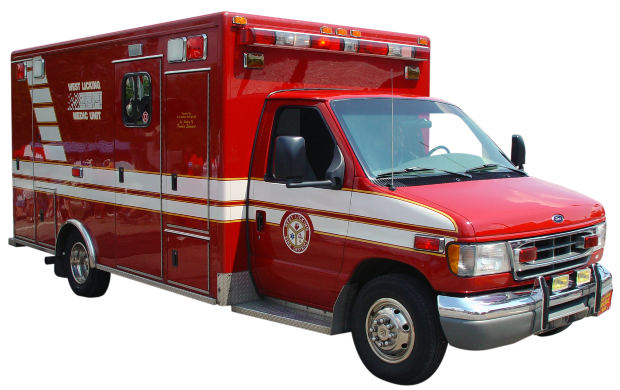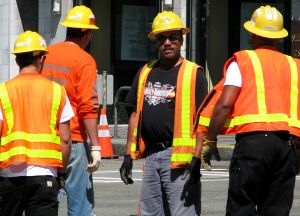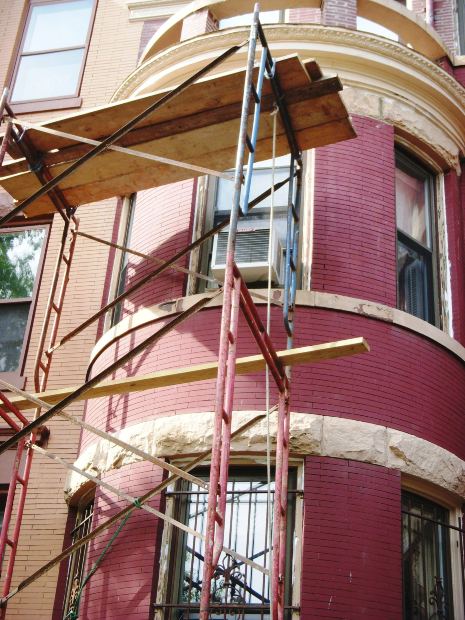Two South Carolina men suffered serious burns after the materials they were working with ignited in an underground diesel gas tank at a Manchester gas station.
According to Manchester Fire Chief James Burkush, the two men were part of a five men crew that was re-lining the interior of a diesel gas tank. The two men were in the gas tank when a flammable chemical resin they were using to affix fiberglass material to the sides of the tank, caught fire.
 Witnesses to the incident said that there was no actual explosion rather there were plumes of heavy smoke rising out of the manhole where the two men were working. One of the men was able to get himself out immediately, but the other worker had to be pulled out by his safety harness. John Brewer, owner of Johnny B’s Car Care which is attached to the Mobile station the men were working at, said that one of the men he cared for had severe burns to his skin and his skin seemed to be melting off.
Witnesses to the incident said that there was no actual explosion rather there were plumes of heavy smoke rising out of the manhole where the two men were working. One of the men was able to get himself out immediately, but the other worker had to be pulled out by his safety harness. John Brewer, owner of Johnny B’s Car Care which is attached to the Mobile station the men were working at, said that one of the men he cared for had severe burns to his skin and his skin seemed to be melting off.
Fire officials believe that an electrical light attached to the edge of the tank started the fire. After they vented the smoke and fire, firefighters were able to go inside the tank, where they were able to recover the light, a respirator, and clothing of the burnt worker. Burkush said that the fiberglass was completely melted and burnt during the fire.
Both men were treated at an area hospital with life-threatening injuries before being flown to a hospital in Boston. Doctors at Elliot Hospital in Manchester, where the men were first treated, said that aside from the burns each of the men sustained, they both suffered from pulmonary and inhalation injuries from smoke and toxic fumes.
——————————————————————————————————————————————
Burns can happen in many different on-the-job situations; whether at a factory, chemical plant, construction site, kitchen, or other type of industrial site. Regardless of their cause, burns (scalds, chemical burns, electrical burns, radiation burns, smoke and inhalation, or contact burns), can be incredibly painful and can cause long-term complications such as scars or disfigurement, and even death.
Continue reading
 Massachusetts Workers' Compensation Lawyer Blog
Massachusetts Workers' Compensation Lawyer Blog


 The victim, Edward Lake II, 60, died as he was unloading a bundle of rebar set to be used in the construction of the new $1.2 billion stadium. Both state and local authorities investigated the incident, and the lead construction manager halted work on the project for the remainder of Monday. The death is the second to take place at the site in four months. According to the contractor, employees would resume work on Tuesday and take part in safety meetings and be offered counseling.
The victim, Edward Lake II, 60, died as he was unloading a bundle of rebar set to be used in the construction of the new $1.2 billion stadium. Both state and local authorities investigated the incident, and the lead construction manager halted work on the project for the remainder of Monday. The death is the second to take place at the site in four months. According to the contractor, employees would resume work on Tuesday and take part in safety meetings and be offered counseling. The construction business remains the most hazardous work industry in the United States, accounting for nearly 20% of all workplace fatalities annually. While both victims in this case are expected to survive, the incident serves as yet another reminder to construction workers of how dangerous their job can be. Carpenters and roofers incur risky situations on a day-to-day basis, and among these types of workers, falls are the leading cause of injury or death. In a report published by The Massachusetts Coalition for Occupational and Safety Health, out of the 32 reported work-related deaths in Massachusetts last year, six were cause by falls.
The construction business remains the most hazardous work industry in the United States, accounting for nearly 20% of all workplace fatalities annually. While both victims in this case are expected to survive, the incident serves as yet another reminder to construction workers of how dangerous their job can be. Carpenters and roofers incur risky situations on a day-to-day basis, and among these types of workers, falls are the leading cause of injury or death. In a report published by The Massachusetts Coalition for Occupational and Safety Health, out of the 32 reported work-related deaths in Massachusetts last year, six were cause by falls.  Witnesses to the incident said that there was no actual explosion rather there were plumes of heavy smoke rising out of the manhole where the two men were working. One of the men was able to get himself out immediately, but the other worker had to be pulled out by his safety harness. John Brewer, owner of Johnny B’s Car Care which is attached to the Mobile station the men were working at, said that one of the men he cared for had severe burns to his skin and his skin seemed to be melting off.
Witnesses to the incident said that there was no actual explosion rather there were plumes of heavy smoke rising out of the manhole where the two men were working. One of the men was able to get himself out immediately, but the other worker had to be pulled out by his safety harness. John Brewer, owner of Johnny B’s Car Care which is attached to the Mobile station the men were working at, said that one of the men he cared for had severe burns to his skin and his skin seemed to be melting off. 






